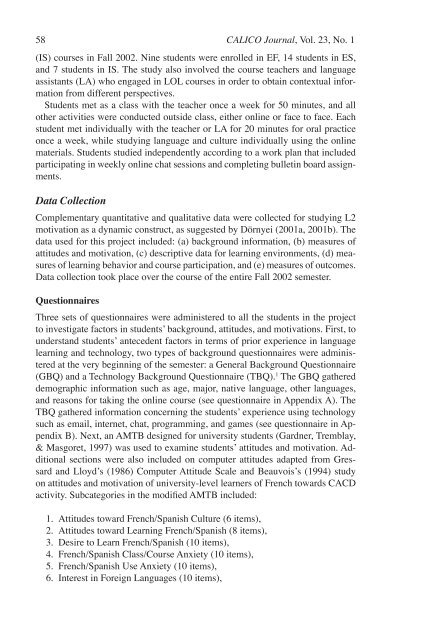The Role of Students' Attitudes and Motivation in Second ... - CALICO
The Role of Students' Attitudes and Motivation in Second ... - CALICO
The Role of Students' Attitudes and Motivation in Second ... - CALICO
You also want an ePaper? Increase the reach of your titles
YUMPU automatically turns print PDFs into web optimized ePapers that Google loves.
58 <strong>CALICO</strong> Journal, Vol. 23, No. 1<br />
(IS) courses <strong>in</strong> Fall 2002. N<strong>in</strong>e students were enrolled <strong>in</strong> EF, 14 students <strong>in</strong> ES,<br />
<strong>and</strong> 7 students <strong>in</strong> IS. <strong>The</strong> study also <strong>in</strong>volved the course teachers <strong>and</strong> language<br />
assistants (LA) who engaged <strong>in</strong> LOL courses <strong>in</strong> order to obta<strong>in</strong> contextual <strong>in</strong>formation<br />
from different perspectives.<br />
Students met as a class with the teacher once a week for 50 m<strong>in</strong>utes, <strong>and</strong> all<br />
other activities were conducted outside class, either onl<strong>in</strong>e or face to face. Each<br />
student met <strong>in</strong>dividually with the teacher or LA for 20 m<strong>in</strong>utes for oral practice<br />
once a week, while study<strong>in</strong>g language <strong>and</strong> culture <strong>in</strong>dividually us<strong>in</strong>g the onl<strong>in</strong>e<br />
materials. Students studied <strong>in</strong>dependently accord<strong>in</strong>g to a work plan that <strong>in</strong>cluded<br />
participat<strong>in</strong>g <strong>in</strong> weekly onl<strong>in</strong>e chat sessions <strong>and</strong> complet<strong>in</strong>g bullet<strong>in</strong> board assignments.<br />
Data Collection<br />
Complementary quantitative <strong>and</strong> qualitative data were collected for study<strong>in</strong>g L2<br />
motivation as a dynamic construct, as suggested by Dörnyei (2001a, 2001b). <strong>The</strong><br />
data used for this project <strong>in</strong>cluded: (a) background <strong>in</strong>formation, (b) measures <strong>of</strong><br />
attitudes <strong>and</strong> motivation, (c) descriptive data for learn<strong>in</strong>g environments, (d) measures<br />
<strong>of</strong> learn<strong>in</strong>g behavior <strong>and</strong> course participation, <strong>and</strong> (e) measures <strong>of</strong> outcomes.<br />
Data collection took place over the course <strong>of</strong> the entire Fall 2002 semester.<br />
Questionnaires<br />
Three sets <strong>of</strong> questionnaires were adm<strong>in</strong>istered to all the students <strong>in</strong> the project<br />
to <strong>in</strong>vestigate factors <strong>in</strong> students’ background, attitudes, <strong>and</strong> motivations. First, to<br />
underst<strong>and</strong> students’ antecedent factors <strong>in</strong> terms <strong>of</strong> prior experience <strong>in</strong> language<br />
learn<strong>in</strong>g <strong>and</strong> technology, two types <strong>of</strong> background questionnaires were adm<strong>in</strong>istered<br />
at the very beg<strong>in</strong>n<strong>in</strong>g <strong>of</strong> the semester: a General Background Questionnaire<br />
(GBQ) <strong>and</strong> a Technology Background Questionnaire (TBQ). 1 <strong>The</strong> GBQ gathered<br />
demographic <strong>in</strong>formation such as age, major, native language, other languages,<br />
<strong>and</strong> reasons for tak<strong>in</strong>g the onl<strong>in</strong>e course (see questionnaire <strong>in</strong> Appendix A). <strong>The</strong><br />
TBQ gathered <strong>in</strong>formation concern<strong>in</strong>g the students’ experience us<strong>in</strong>g technology<br />
such as email, <strong>in</strong>ternet, chat, programm<strong>in</strong>g, <strong>and</strong> games (see questionnaire <strong>in</strong> Appendix<br />
B). Next, an AMTB designed for university students (Gardner, Tremblay,<br />
& Masgoret, 1997) was used to exam<strong>in</strong>e students’ attitudes <strong>and</strong> motivation. Additional<br />
sections were also <strong>in</strong>cluded on computer attitudes adapted from Gressard<br />
<strong>and</strong> Lloyd’s (1986) Computer Attitude Scale <strong>and</strong> Beauvois’s (1994) study<br />
on attitudes <strong>and</strong> motivation <strong>of</strong> university-level learners <strong>of</strong> French towards CACD<br />
activity. Subcategories <strong>in</strong> the modified AMTB <strong>in</strong>cluded:<br />
1. <strong>Attitudes</strong> toward French/Spanish Culture (6 items),<br />
2. <strong>Attitudes</strong> toward Learn<strong>in</strong>g French/Spanish (8 items),<br />
3. Desire to Learn French/Spanish (10 items),<br />
4. French/Spanish Class/Course Anxiety (10 items),<br />
5. French/Spanish Use Anxiety (10 items),<br />
6. Interest <strong>in</strong> Foreign Languages (10 items),
















